8 Voice of Customer Tools to Monitor Customer Experience
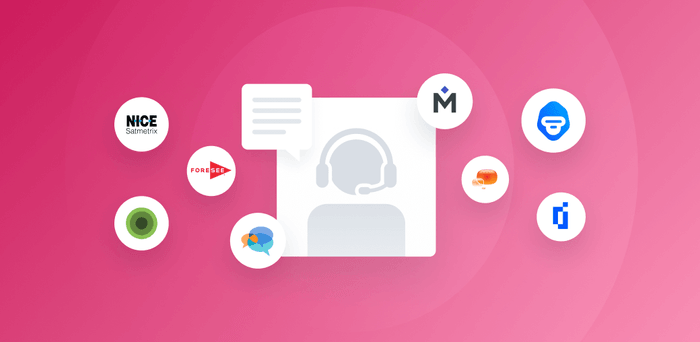
Customer needs and demands only continue to grow as we find ourselves deeply entrenched in the customer experience (CX) era. Customers expect more than ever from the brands they use.
To meet ever-increasing customer needs, businesses are more focused than ever on voice of the customer (VoC) analysis, which involves collecting customer feedback and analyzing it for customer insights.
VoC tools can tell you how your customers use your products and services, uncover the major pain points on the customer journey, and understand customers’ general satisfaction with their purchases – in order to improve products and services and the overall customer experience.
Talk with our VoC experts
There are a number of VoC tools you can put to work on your customer data to better understand customers’ opinions, needs, and desires, and create a full-fledged VoC program.
What Are Voice of Customer Tools?
Voice of customer (VoC) tools are applications and processes used to collect and analyze customer feedback from surveys, customer service interactions, product reviews, social media, etc., in order to become more customer-centric and make data-driven decisions to improve your business.
The techniques they offer vary from simple quantitative data analysis to AI-guided text analysis, like sentiment analysis, automatic ticket tagging, data mapping, and more.
Some voice of customer software simply analyzes user behavior, others dive deeper into unstructured data, and some are focused on reporting on the analyses (with visualizations and predictive analyses), and some can do all of the above.
Let’s dive into the top VoC tools to help you get the data and analyses you need.
Top 8 Enterprise Voice of Customer Tools & Platforms in 2022
The best VoC tools on the market to tailor your own voice of customer program.
- MonkeyLearn | VoC software to analyze & visualize qualitative data
- Medallia | Voice of customer management for voice insights
- Sentisum | Intelligent voice of customer support
- ConfirmIt | A VoC solution to uncover deeper insights
- InMoment | A “Experience Improvement” tool
- Clarabridge | Following the voice of customer from start to finish
- Verint ForeSEE | Multidisciplinary VoC analytics and real-time alerts
- NICE Satmetrix | Brand ambassador metrics from the creator of NPS
1. MonkeyLearn
MonkeyLearn is a no-code text analysis platform that can take you from voice of customer analysis to data visualization in just a few steps. Analyze your qualitative data to understand the VoC and streamline internal processes using integrations with tools, like Zendesk, Freshdesk, Zapier, Google Sheets, and more.
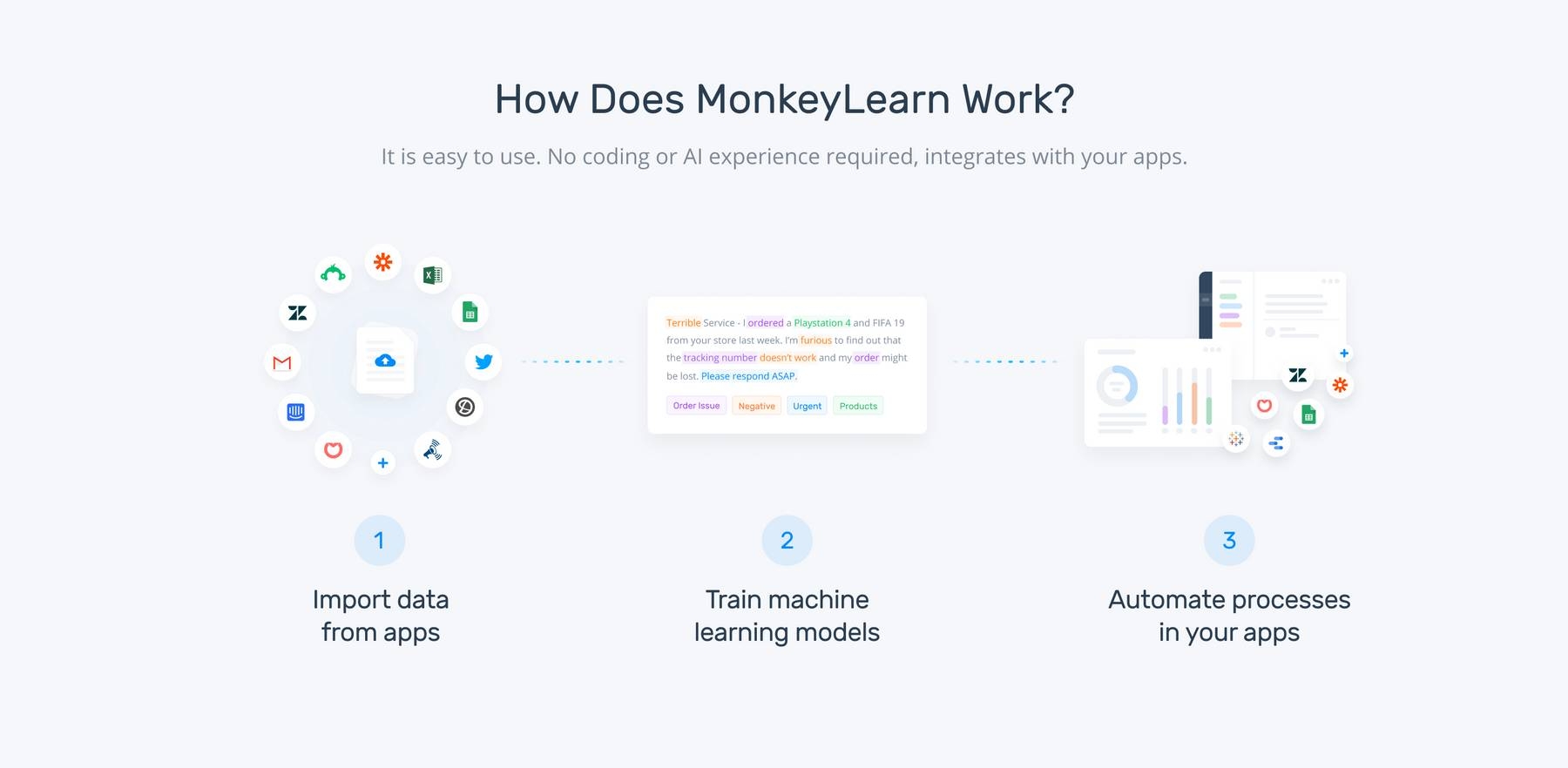
You can set up omnichannel support, automate ticket tagging and routing, and extract and analyze your customer feedback for real-time voice of customer insights.
Aspect-based sentiment analysis, for example, can automatically organize customer feedback, first, by topic, like Support, Reliability, Pricing, etc. Then automatically analyze it for sentiment so you understand the positive or negative opinions behind individual comments and overall aspects of your business.
Take a look at this MonkeyLearn Studio dashboard showing granular topic and sentiment results from a set of customer reviews:
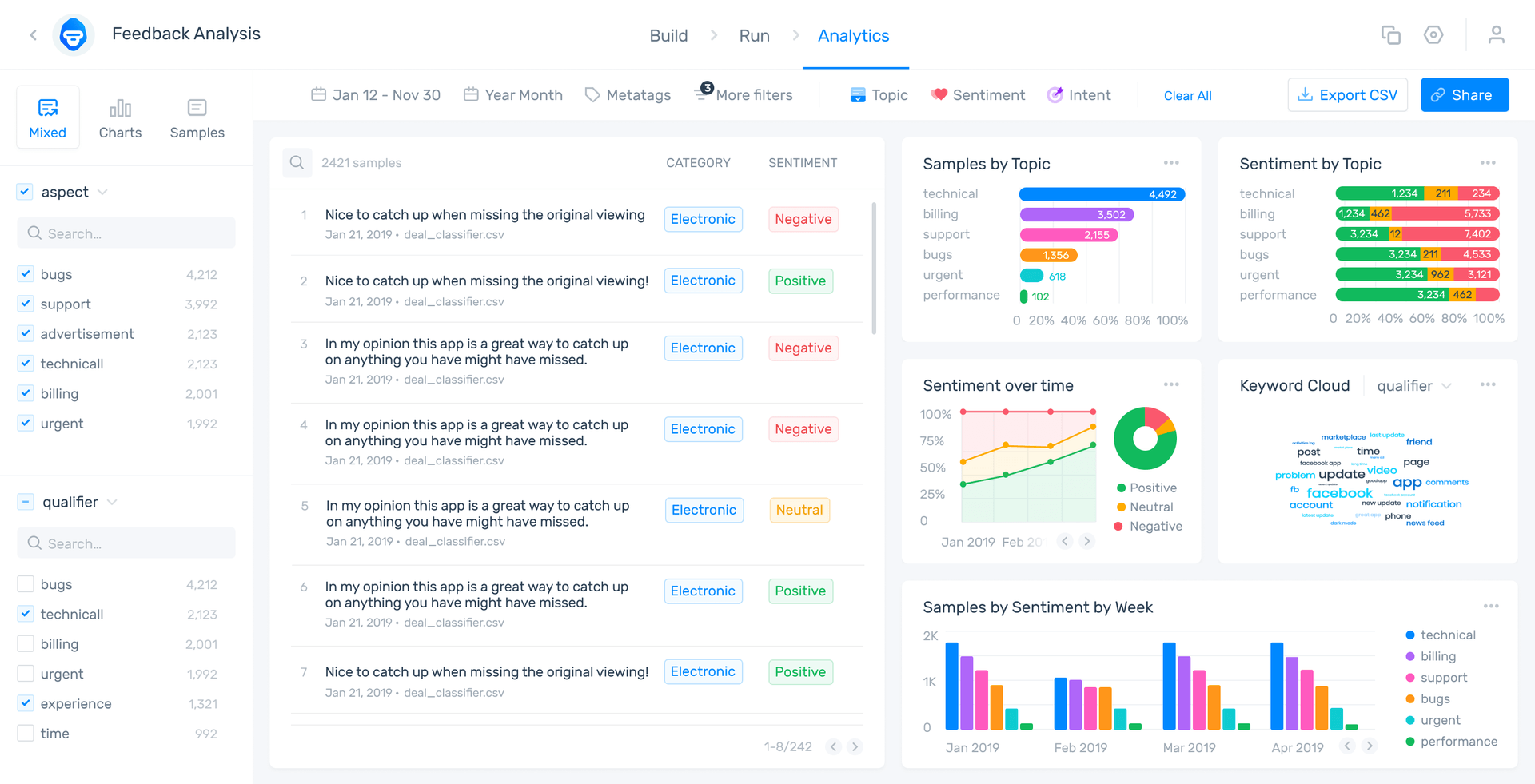
MonkeyLearn’s visual dashboard delivers instant voice of customer insights to help understand why your customers are making decisions.
Filter by product, keyword, sentiment, and more, to dive even deeper into your data. Want to know what makes your customers tick and what they hate?
Request a demo or view plans and pricing to take your voice of customer insights to the next level.
2. Medallia
Medallia is focused on experience management (XM), which can be simply explained as “voice of everyone” – aiming to improve the experiences between a company and all entities they interact with: employees, customers, vendors, company stakeholders, etc.
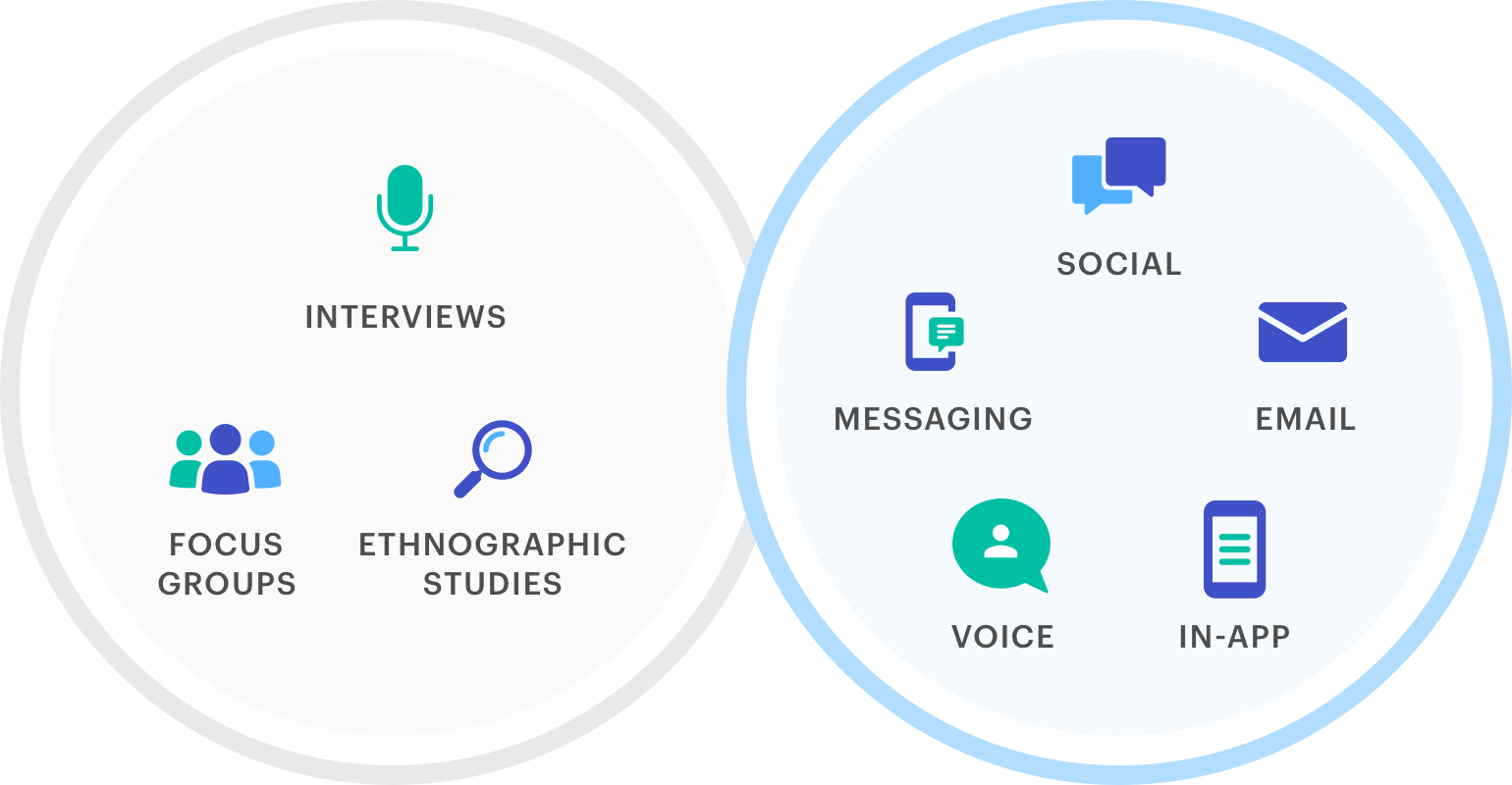
The feedback management software helps you collect both solicited and unsolicited feedback, and translates it into real-time insights. Helping you understand what your customers are experiencing.
Their CX apps, Medallia Mobile and Medallia Voices, combine customer survey data, internal customer data, and web use data analytics to offer immediate results on mobile devices, so users always have the most recent data at the ready.
For their most advanced VoC results, you can combine the above with other VoC tools, like sentiment analysis, in the Medallia Experience Cloud to detect patterns and anticipate the needs of customers.
3. Sentisum
SentiSum focuses on analyzing voice of the customer in support tickets. The platform automatically tags tickets by topic and sentiment using AI, otherwise known as aspect-based sentiment analysis, to help companies understand customer experience at a granular level.
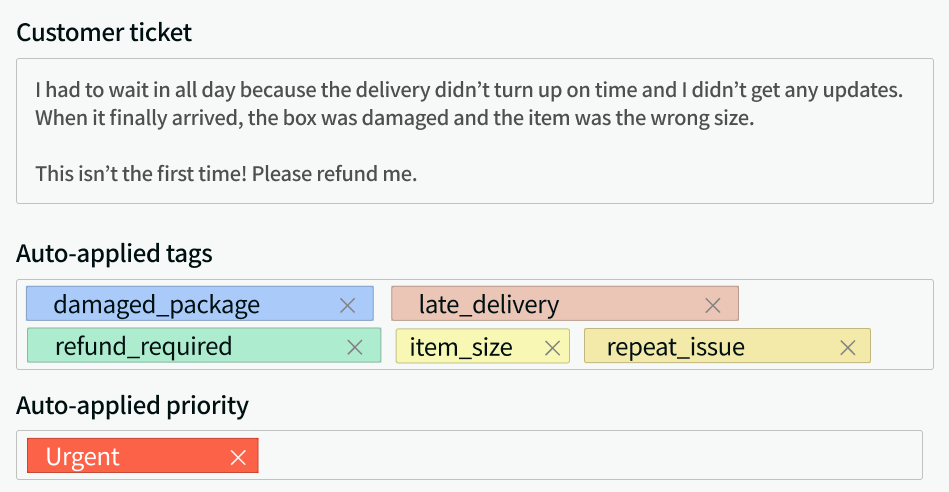
The VoC software is easy to use, and can easily identify and report areas for improvement, as well as automate tasks like routing, prioritization, and more.
Connect your data through integrations like Zendesk and Freshdesk, and transcribe your voice calls into text so you can perform AI analytics on all voice of customer data.
4. Confirmit
Confirmit presents a 5-stage process to analyze the voice of customer, allowing businesses to listen to customer feedback, integrate operational and free-form text data, and generate powerful insights:
- Define business needs and issues.
- Design a VoC program to these needs.
- Listen to VoC with multi-channel data collection.
- Analyze your feedback with a variety of techniques from structured to unstructured data analysis.
- Act on the results.
This process combines customer experience analytics with employee engagement and market research to offer a “big picture” analysis.
5. InMoment
Cloud-based, InMoment, presupposes that companies likely already have issues with customer experience, product experience (PX), etc., so they use the term “experience improvement (XI)” to describe how they wish to “transform the way your organization approaches business initiatives.”
InMoment’s Experience Hub combines a variety of techniques, like Social Reviews and Advocacy, VoC, and Employee Engagement to offer a holistic approach to a company’s overall interaction with employees and the public.
6. Clarabridge
Clarabridge’s strategy for VoC analysis is to manage the customer journey from start to finish by analyzing customer effort, customer engagement, and customer emotion to understand how customers feel about every aspect of a business.
Their 11-point sentiment analysis scale uses sentence context, industry-specific language, and stemming and lemmatization to go beyond simple “positive” and “negative” ratings of open-ended comments and responses. They also offer high-performing voice analysis and speech-to-text analytics for businesses that mainly deal with customer feedback over the phone.
7. Verint ForeSEE
Verint ForeSEE offers the Vering Experience Cloud, a multidisciplinary, multi-technique VoC analysis solution that seeks customer feedback and ensures that a company’s internal teams are notified to encourage collaboration and “close the feedback loop,” so customers are never left out in the cold. Verint’s XM tools offer real-time alerts and easy-to-use dashboard to map VoC from start to finish.
8. NICE Satmetrix
Co-developed by one of the creators of the Net Promoter Score, NICE Satmetrix is steeped in VoC analysis. It’s an all-around customer experience program designed to integrate internal processes and data gathering to deliver insights and drive “your action management process.”
As Satmetrix’s creation is born of the Net Promoter philosophy, it’s no surprise that it’s heavily focused on increasing brand loyalty and cultivating brand ambassadors. NICE Satmetrix is perfect for the modern social media marketing age.
Get Started With VoC Software
It’s clear that VoC software is important, to help keep track of what your customers are saying and improve their overall experience.
Some voice of customer tools collect and analyze your data, but only scratch the surface of what customers are trying to tell you. Others provide a more in-depth view of your customers’ thoughts and opinions.
Ready to explore your VoC tool options?
Take a look at MonkeyLearn’s VoC software to see how you you can easily set up your VoC program – no matter your data type or use case.
Or request a demo to see how MonkeyLearn can help you build a comprehensive VoC program, starting today.

Tobias Geisler Mesevage
March 9th, 2021






